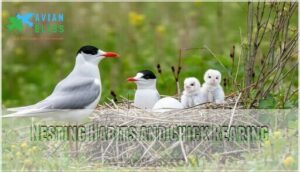This site is supported by our readers. We may earn a commission, at no cost to you, if you purchase through links.

They’re masters of precision diving, plunging from 40 feet to snag small fish. Unfortunately, they’re fighting for survival—the northeastern population is federally endangered, down 75% since the 1930s. With over 90% nesting at just three critical sites, they’re incredibly vulnerable to habitat loss and human disturbance.
Understanding their identification secrets becomes essential for their conservation success.
Table Of Contents
- Key Takeaways
- Roseate Tern Identification and Description
- Habitat and Global Distribution
- Behavior, Foraging, and Social Patterns
- Breeding, Nesting, and Migration
- Conservation Status and Major Threats
- Frequently Asked Questions (FAQs)
- Are Roseate Terns endangered?
- What is the difference between a common tern and a roseate tern?
- Where does the roseate tern live?
- What are some interesting facts about the roseate tern?
- How do roseate terns protect themselves from predators?
- What is the average lifespan of a roseate tern in the wild?
- How do roseate terns communicate with each other during breeding season?
- How long do roseate terns live?
- What predators threaten roseate tern colonies?
- How many eggs do roseate terns lay?
- Conclusion
Key Takeaways
- You’ll identify roseate terns by their exceptionally long, forked tails extending beyond wingtips, straight black bills, and slender builds that distinguish them from bulkier common terns.
- You’re looking at a critically endangered species – the northeastern population has declined 75% since the 1930s, with over 90% nesting at just three vulnerable sites.
- You’ll find these precision divers plunging from 40 feet to catch small fish in coastal waters from Nova Scotia to the Caribbean, then migrating directly across the Atlantic to South America.
- You can help by reporting sightings to eBird and supporting habitat protection efforts, since accurate identification and conservation action are essential for this species’ survival.
Roseate Tern Identification and Description
You’ll quickly recognize the Roseate Tern by its exceptionally long, forked tail that extends well beyond its wingtips when perched, setting it apart from similar coastal species.
Watch for its slender build, straight black bill, and pale gray upperparts that distinguish this endangered seabird from the more common terns you’ll encounter along North Atlantic shores.
Plumage and Coloration
How does the Roseate Tern’s color pattern reveal identification clues? You’ll notice the black bill (orange in Caribbean populations) and distinctive rosy wash across the underparts during molt cycles.
Key identification features include:
- Chalky white plumage with pale gray upperwings
- Striking black cap and faintly rosy underparts
- Dark outer primaries creating subtle wing patterns
Beak color varies by subspecies—Caribbean birds sport fully red bills while North Atlantic populations show minimal red at the base.
Understanding the species’ seabird characteristics is vital for accurate identification and conservation efforts.
Size and Body Shape
When identifying these elegant seabirds, you’ll notice their slender body proportions immediately set them apart. Measuring 13-16 inches long, they’re roughly robin-sized with exceptionally long wing length extending beyond their distinctive forked tail at rest.
Their thin beak size appears delicate compared to bulkier terns. The relative size falls between Least and Sandwich Terns, while their graceful wingbeats reveal aerodynamically efficient feather texture perfectly adapted for marine life.
Distinctive Features
Look for the trademark characteristics that set roseate terns apart. The forked tail extends beyond wingtips when perched, creating an elegant silhouette. Bill coloration varies by season—mostly black in winter, developing red at the base during breeding.
These whiter wings and shallow, choppy wingbeats distinguish them from similar species. Their slender beak structure and distinctive feather patterns provide clear identification markers.
Comparison to Common Tern
When spotting these tern species together, notice key differences. Common Tern has a heavier build and broader wings compared to the Roseate Tern’s slender frame.
Here are three identification tips:
- Bill Coloration: Roseate Tern shows a mostly black bill, while Common Tern displays a red bill with a black tip
- Tail Length: Roseate Tern’s extraordinarily long, forked tail extends beyond wingtips
- Whiter Wings: Roseate Tern appears paler overall with gleaming white plumage versus Common Tern’s grayer tones
Habitat and Global Distribution
You’ll find Roseate Terns in coastal waters across two distinct North American populations. The northeastern group breeds from Nova Scotia to New York, while the Caribbean population nests in the Florida Keys, Cuba, and the Bahamas.
These elegant seabirds prefer protected marine environments like barrier islands, salt marshes, and offshore cays. Here, they can establish colonies safely away from mainland predators.
North American Populations
Along North America’s Atlantic seaboard, endangered Roseate Tern populations face extinction threats. The Northeast population, breeding from the Magdalen Islands to New York, is federally listed as endangered. These breeding colonies concentrate on protected coastal islands, requiring intensive Conservation Efforts.
Population Trends show continuing declines, with Colony Dynamics heavily dependent on habitat management and predator control for survival. The roseate tern’s survival relies on addressing sea level threats to protect its habitat.
Caribbean and Worldwide Locations
Beyond North America’s shores, Roseate Tern (Sterna dougallii) breeding colonies span six continents in diverse Marine Ecosystems. Caribbean populations inhabit Island Habitats across Puerto Rico, Florida Keys, and Virgin Islands, forming vital Seabird Sanctuaries.
Global Distribution includes Europe’s Rockabill Island and Pacific regions from East Africa to Australia. Regional Differences exist among four subspecies, with Coastal Migration patterns connecting these distant Habitat zones worldwide.
Preferred Coastal Environments
You’ll find these elegant terns thriving in protected coastal waters where habitat management combats coastal erosion and shoreline development. They nest on beaches and salt marsh islands with sparse vegetation, preferring spots tucked under boulders or beachgrass.
Marine pollution threatens their feeding grounds in estuaries and mudflats, making wetland conservation essential for their survival.
Behavior, Foraging, and Social Patterns
You’ll notice roseate terns exhibit impressive precision in their aerial hunting techniques, with their sleek bodies allowing them to execute swift, controlled plunges into coastal waters for small fish and marine invertebrates.
These highly social seabirds form dense breeding colonies where their distinctive calls and synchronized flight patterns create a complex communication system that’s essential for successful reproduction and chick-rearing in their increasingly threatened coastal habitats.
Flight and Aerial Skills
Their aerial prowess makes Roseate Terns true masters of flight. These birds display outstanding aerodynamic features and behavior patterns across their range. Watch for these impressive Aerial Maneuvers:
- Strong, fast flyer with rapid, shallow beats of relatively short, pointed wings
- Wing Structure designed for precision diving and oceanic migration patterns
- Swoops and dives for fish with extra-long tail fluttering behind
- Flight Speed optimized for their specialized soaring techniques during courtship displays
Feeding and Diet
You’ll spot Roseate Terns performing impressive plunge-diving techniques from heights up to 40 feet. Their Diet Composition centers on small fish like herring and sand eels, plus occasional crustaceans.
These birds master Foraging Techniques including surface-dipping and even kleptoparasitism—stealing catches from Common Terns.
Sea Level Rise threatens Food Availability in Coastal Ecosystems, making Habitat Protection essential for Wildlife Management.
Social Behavior and Vocalizations
Within colony dynamics, you’ll notice Roseate Terns use distinct communication styles that set them apart. Their vocal array includes a high-pitched chi-vik advertising call, and musical kliu and raspy aaach alarm calls.
The call of the roseate tern is a very characteristic chuwit , helping with tern identification during bird breeding habits and migration patterns.
Breeding, Nesting, and Migration
You’ll discover that Roseate Terns concentrate their breeding efforts in just a few critical coastal colonies from Nova Scotia to New York, with over 90% of the endangered Northeastern population nesting at three major sites.
These elegant seabirds undertake impressive migrations, flying directly over the Atlantic Ocean to reach their South American wintering grounds along Brazil’s coast and the Caribbean each fall.
Breeding Colonies and Locations
You’ll find most breeding colonies clustered in surprisingly few locations, making them vulnerable to environmental threats. Colony Management focuses on protecting these critical nesting sites through careful location mapping and habitat preservation. Over 90% of northeastern populations concentrate at just three major breeding grounds: Bird Island (2,400 pairs), Great Gull Island (2,200 pairs), and Ram Island (1,200 pairs).
- Northeastern colonies stretch from Nova Scotia to New York, with secondary sites in Quebec, Virginia, Maryland, and New Jersey
- Caribbean populations breed on islands in Cuba, Florida Keys, Bahamas, and Virgin Islands
- International colonies include UK’s Coquet Island and Ireland’s Rockabill Island
Nesting Habits and Chick Rearing
During the breeding season, you’ll discover that Roseate Terns exhibit fascinating nest site selection strategies. Male and female investigate potential nest sites together, selecting a site on the ground near vegetation, with both parents spending roughly equal amounts of time incubating.
Parental care involves shared responsibilities for brooding and feeding chicks. Chicks fledge 25 to 28 days after hatching, with impressive fledgling success rates in proper breeding colonies and suitable nesting habitat.
Migration Routes and Wintering Grounds
Once chicks fledge, you’ll witness astonishing Atlantic crossings as roseate terns follow ancient flyway patterns. These threatened seabirds navigate directly from North America to South American habitats, timing migration perfectly in late August through September.
Tern migration patterns show impressive precision – they utilize offshore islands as stepping stones, demonstrating geographical variation in routes while maintaining consistent wintering sites along Brazil’s coast.
Conservation Status and Major Threats
You’ll find that Roseate Terns face serious conservation challenges, with the Northeastern population federally listed as endangered and Caribbean populations listed as threatened.
Human disturbance, habitat loss from coastal development, and rising sea levels threaten the species’ survival across its limited breeding colonies.
Endangered and Threatened Populations
Roseate Terns face mounting extinction risk through Population Decline across their range. The Northeastern population is federally endangered, while Caribbean populations remain threatened.
The northeastern Roseate Tern population faces federal endangerment while Caribbean populations remain threatened with mounting extinction risks
Conservation Strategies must address:
- 75% population drop since 1930s
- Concentrated breeding in few colonies creates Species Vulnerability
- Continuing declines in abundance and habitat documented
- Limited genetic diversity between separated populations
- Threat Assessment reveals multiple risk factors converging
87% of New York’s population nests in only one colony, highlighting how endangered species face amplified extinction risk.
Human Disturbance and Habitat Loss
Coastal development continues chipping away at the roseate tern’s precious nesting habitat, while human disturbances during critical breeding seasons send these sensitive birds packing. Habitat destruction from development, rising sea levels, and human disturbance are primary threats.
Beach recreation, boat traffic, and coastal construction create ecosystem disruption that forces species decline. These human impacts contribute directly to their vulnerability and declining populations, compromising their already fragile conservation status.
Conservation Efforts and Legal Protections
You’ll find powerful legal shields protecting roseate terns through Conservation Laws like the Endangered Species Act and Migratory Bird Treaty Act. These Wildlife Management frameworks create strict penalties for disturbing nests or birds.
Habitat Preservation efforts include designated sanctuaries and restoration projects that’ve doubled nesting sites at key colonies.
Environmental Policy backs Species Protection through international agreements, while ongoing Wildlife Preservation monitoring tracks recovery progress toward delisting goals.
Frequently Asked Questions (FAQs)
Are Roseate Terns endangered?
Facing extinction isn’t just a phrase here – it’s reality. You’re looking at a species where the Northeast population is federally listed as endangered, while Caribbean populations are threatened.
Conservation efforts continue.
What is the difference between a common tern and a roseate tern?
You’ll spot key differences immediately when comparing these species. Roseate terns have slimmer builds, thinner black bills, and longer forked tails compared to common terns’ heavier bodies with red bills and shorter tails.
Where does the roseate tern live?
You’ll discover roseate terns inhabiting coastal waters from Nova Scotia to New York, with Caribbean populations nesting on Florida Keys islands and Bahamas cays.
What are some interesting facts about the roseate tern?
You’ll encounter stunning seabirds known for their deepest forked tails and 25-year lifespans. Their distinctive pink breast wash and ocean-diving grace make them conservation success stories after near extinction from the 19th-century plume trade.
How do roseate terns protect themselves from predators?
You’ll find these seabirds have clever survival tactics. Roseates are less aggressive than common terns and rely on them for defense in the colony.
They also construct a simple scrape as a nest, usually hiding it from predators under some sort of protective cover.
What is the average lifespan of a roseate tern in the wild?
Studies show these hardy seabirds usually live eight years in wild conditions. You’ll find most averaging around eight years, though some exceptional individuals reach 25+ years with proper conditions.
How do roseate terns communicate with each other during breeding season?
You’ll hear their distinctive high-pitched "chi-vik" calls echoing across breeding colonies, along with musical kliu and raspy aaach alarm calls.
A clipped, high-pitched keek is the most common call that helps mates coordinate nesting duties.
How long do roseate terns live?
Life’s brief dance allows these coastal wanderers to grace our world for about 8 years on average.
You’ll discover they can reach notable ages—the longest-lived individual survived 7 years, though most don’t exceed a decade.
What predators threaten roseate tern colonies?
You’ll face mammalian predators like raccoons and avian threats targeting eggs, chicks, and adults. Birds and mammals, snakes, ants, and land crabs create constant colony challenges.
How many eggs do roseate terns lay?
Clutch mystery unfolds! You’ll find most roseate terns lay one or two eggs per clutch, with older females usually laying two eggs while younger ones lay just one. They nest once annually.
Conclusion
Like delicate ribbons dancing on ocean winds, the roseate tern’s survival hangs by a thread. You’ve learned the field marks that separate this endangered seabird from its common cousins—the streaming tail, rosy flush, and refined elegance.
Every accurate identification you make contributes to essential conservation data. Report your roseate tern sightings to eBird and local wildlife agencies. Support habitat protection efforts at critical nesting colonies. This graceful seabird’s future depends on your awareness and action today.
- https://extapps.dec.ny.gov/docs/wildlife_pdf/sgcnroseatetern.pdf
- https://ecos.fws.gov/ecp/species/B07O
- https://www.maine.gov/ifw/docs/endangered/roseatetern_48_49.pdf
- https://myfwc.com/wildlifehabitats/profiles/birds/shorebirdsseabirds/roseate-tern/
- https://stateofthebirds.nhaudubon.org/bird_database/roseate-tern/













